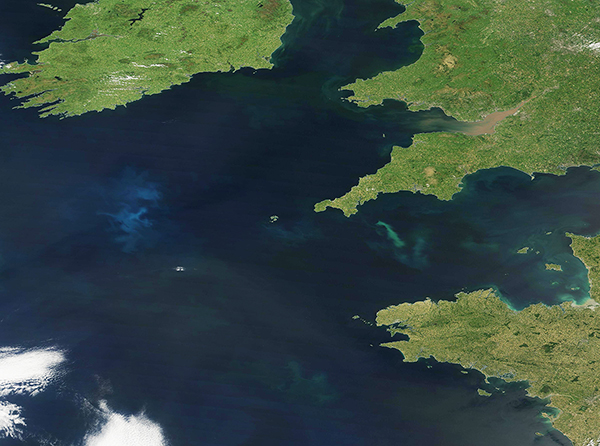Images
June 8, 2023 - Phytoplankton Bloom off Western Europe
Tweet
A large patch of bright blue marked the presence of a spring bloom of phytoplankton in Western Europe in early June 2023. The Moderate Resolution Imaging Spectroradiometer (MODIS) on board NASA’s Terra satellite acquired a true-color image of the blooming Celtic Sea on June 6. The bloom was located in south of Ireland and west of Wales (northeast), England (south of Wales) and France (southeast).
Each spring, lengthening sunlight provides the energy for the floating, microscopic, plant-like organisms to reproduce rapidly in this location. The first phytoplankton to appear are often a type called “coccolithophores”, which have a distinct milky-view color when a bloom is visible from space. What makes coccolithophores different from other species of phytoplankton is their calcite shells and their ability to live in more temperate waters with fewer nutrients than many other species.
Aside from coloring ocean waters, phytoplankton play a large role in sustaining ocean ecosystems and in global climate. The tiny plants are the base of the marine food chain, and places where blooms are frequent tend to support a thriving marine population. Phytoplankton can influence global climate by regulating gases in the atmosphere. Like all plants, phytoplankton absorb carbon dioxide and release oxygen as they grow. When the plants die, they sink to the ocean floor, carrying the absorbed carbon with them, creating a carbon sink that helps trap carbon dioxide (an important greenhouse gas) and remove it from the atmosphere.
Image Facts
Satellite:
Terra
Date Acquired: 6/4/2023
Resolutions:
1km (614.5 KB), 500m (1.7 MB), 250m (4 MB)
Bands Used: 1,4,3
Image Credit:
MODIS Land Rapid Response Team, NASA GSFC
Tweet
A large patch of bright blue marked the presence of a spring bloom of phytoplankton in Western Europe in early June 2023. The Moderate Resolution Imaging Spectroradiometer (MODIS) on board NASA’s Terra satellite acquired a true-color image of the blooming Celtic Sea on June 6. The bloom was located in south of Ireland and west of Wales (northeast), England (south of Wales) and France (southeast).
Each spring, lengthening sunlight provides the energy for the floating, microscopic, plant-like organisms to reproduce rapidly in this location. The first phytoplankton to appear are often a type called “coccolithophores”, which have a distinct milky-view color when a bloom is visible from space. What makes coccolithophores different from other species of phytoplankton is their calcite shells and their ability to live in more temperate waters with fewer nutrients than many other species.
Aside from coloring ocean waters, phytoplankton play a large role in sustaining ocean ecosystems and in global climate. The tiny plants are the base of the marine food chain, and places where blooms are frequent tend to support a thriving marine population. Phytoplankton can influence global climate by regulating gases in the atmosphere. Like all plants, phytoplankton absorb carbon dioxide and release oxygen as they grow. When the plants die, they sink to the ocean floor, carrying the absorbed carbon with them, creating a carbon sink that helps trap carbon dioxide (an important greenhouse gas) and remove it from the atmosphere.
Image Facts
Satellite:
Terra
Date Acquired: 6/4/2023
Resolutions:
1km (614.5 KB), 500m (1.7 MB), 250m (4 MB)
Bands Used: 1,4,3
Image Credit:
MODIS Land Rapid Response Team, NASA GSFC




